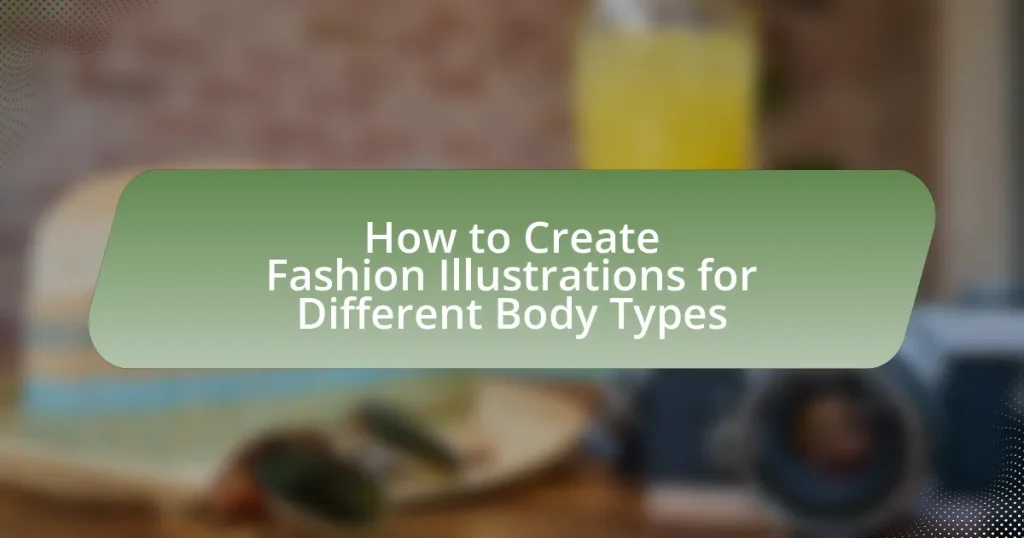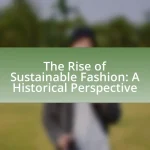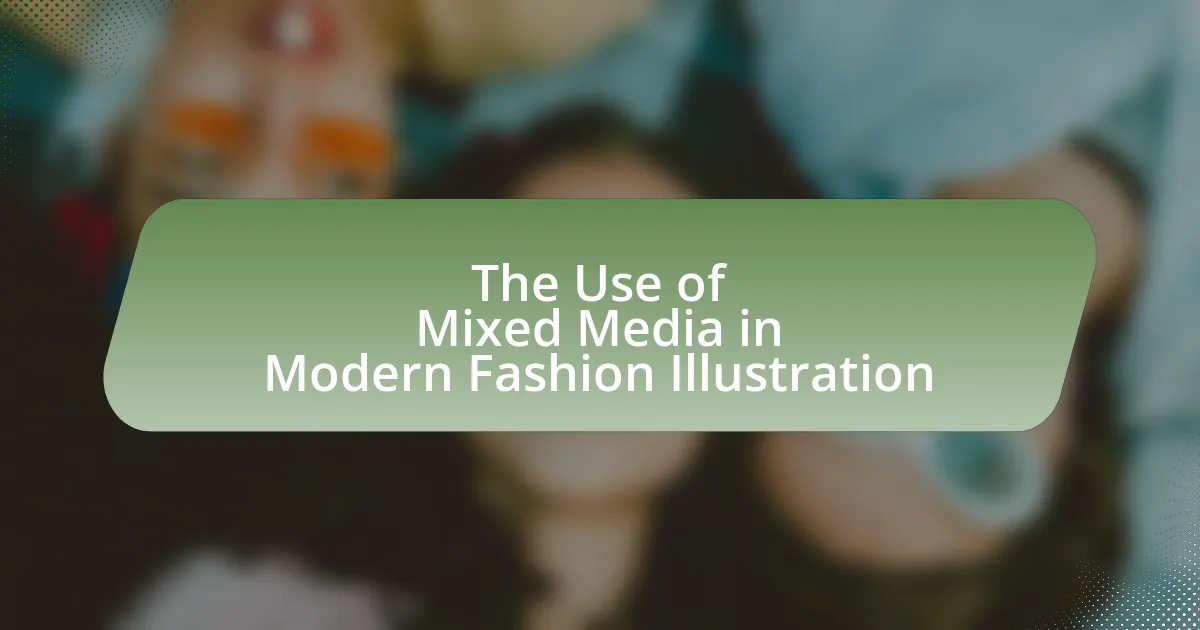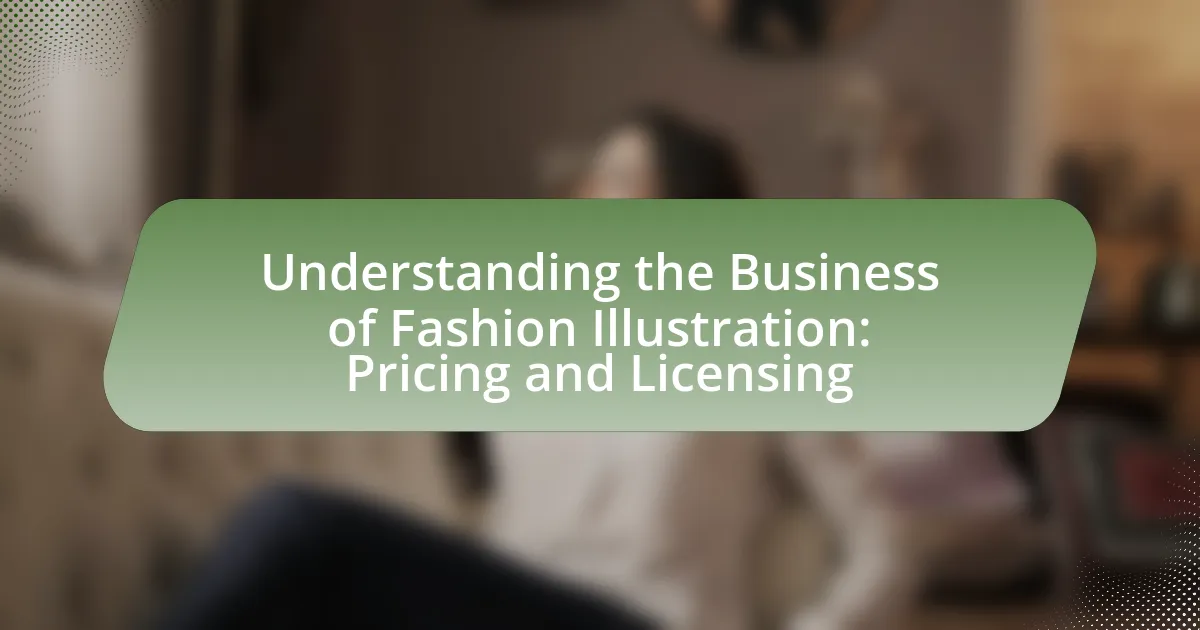Fashion illustrations are essential visual tools in the fashion industry, serving to communicate design concepts and showcase garments on stylized figures. This article explores the significance of fashion illustrations, their historical context, and the techniques used to create them, particularly for diverse body types. It emphasizes the importance of accurately representing various body shapes, such as hourglass, pear, apple, and rectangle, to promote inclusivity and body positivity. Additionally, the article discusses best practices for tailoring illustrations to reflect different body types, the role of color and fabric choices, and the advantages of using digital and mixed media techniques in fashion illustration. Resources for further learning about body diversity in fashion illustration are also provided.
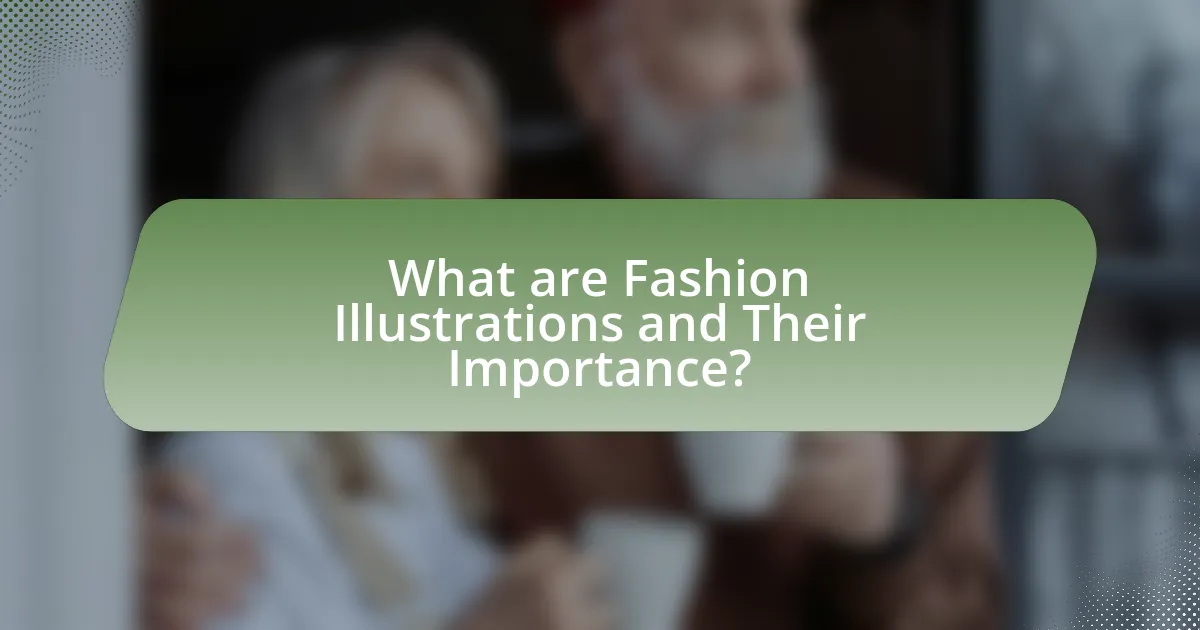
What are Fashion Illustrations and Their Importance?
Fashion illustrations are visual representations of clothing designs, showcasing garments on stylized figures. Their importance lies in their ability to communicate design concepts effectively, allowing designers to convey ideas to clients, manufacturers, and the public. Historically, fashion illustrations have played a crucial role in the fashion industry, with notable examples dating back to the 19th century, where they were used in magazines and advertisements to promote styles. Additionally, these illustrations serve as a tool for designers to experiment with color, fabric, and form, facilitating the creative process before actual garments are produced.
How do fashion illustrations differ from other forms of art?
Fashion illustrations differ from other forms of art primarily in their focus on clothing and fashion design, serving as a visual representation of garments and styles rather than purely aesthetic or conceptual expressions. Unlike traditional art forms that may prioritize emotional expression or abstract concepts, fashion illustrations emphasize the functionality and appeal of fashion items, often incorporating specific details like fabric texture, color, and fit to communicate design intent. This practical application is evident in the work of renowned fashion illustrators like David Downton, who captures the essence of fashion through precise detailing and stylization, making the illustrations not only artistic but also a tool for designers to visualize their concepts.
What techniques are commonly used in fashion illustrations?
Common techniques used in fashion illustrations include sketching, watercolor painting, digital illustration, and mixed media. Sketching allows for quick representation of ideas and poses, while watercolor painting adds depth and vibrancy to designs. Digital illustration has gained popularity due to its versatility and ease of editing, enabling artists to create detailed and polished images. Mixed media combines various materials, enhancing texture and visual interest. These techniques are widely recognized in the fashion industry for their effectiveness in conveying style and form.
Why are fashion illustrations essential in the fashion industry?
Fashion illustrations are essential in the fashion industry because they serve as a visual communication tool that conveys design concepts effectively. These illustrations allow designers to express their creative ideas and showcase garments in a stylized manner, making it easier for stakeholders, such as manufacturers and retailers, to understand the vision behind a collection. Historically, fashion illustrations have been pivotal in the marketing and promotion of fashion, with iconic examples dating back to the 19th century, where they helped shape public perception of style and trends. Additionally, they facilitate collaboration among teams by providing a clear reference point for discussions about fit, fabric, and overall aesthetic, thus streamlining the design process.
What role do body types play in fashion illustrations?
Body types play a crucial role in fashion illustrations by influencing the representation of clothing fit and style. Fashion illustrators tailor their designs to reflect the unique proportions and characteristics of different body types, ensuring that the illustrations resonate with a diverse audience. For instance, studies show that illustrations that accurately depict various body shapes can enhance body positivity and inclusivity in fashion, as they allow consumers to visualize how garments may look on themselves. This approach not only promotes a broader acceptance of beauty standards but also encourages brands to cater to a wider range of customers, ultimately impacting purchasing decisions and brand loyalty.
How can understanding body types enhance illustration accuracy?
Understanding body types enhances illustration accuracy by allowing artists to depict proportions, shapes, and features that reflect real human diversity. Accurate representation of body types ensures that illustrations resonate with a wider audience, making them more relatable and effective in conveying fashion concepts. Research indicates that illustrations that align with various body types can improve viewer engagement and satisfaction, as seen in studies on consumer behavior in fashion marketing.
What are the common body types to consider in fashion illustrations?
The common body types to consider in fashion illustrations are the hourglass, pear, apple, rectangle, and inverted triangle. Each body type has distinct proportions that influence how clothing fits and drapes. For instance, the hourglass figure features a well-defined waist with balanced bust and hip measurements, while the pear shape has a smaller upper body and wider hips. The apple body type typically has a fuller upper body with narrower hips, the rectangle shape has similar measurements for bust, waist, and hips, and the inverted triangle features broader shoulders with narrower hips. Understanding these body types is essential for creating accurate and relatable fashion illustrations that reflect diverse body shapes.

How to Identify Different Body Types for Fashion Illustrations?
To identify different body types for fashion illustrations, one can categorize them into four primary shapes: hourglass, pear, apple, and rectangle. Each body type has distinct characteristics; for instance, the hourglass figure features a well-defined waist with balanced bust and hip measurements, while the pear shape has a smaller upper body and wider hips. The apple body type typically has a fuller upper body with a less defined waist, and the rectangle shape is characterized by similar measurements across the bust, waist, and hips. Understanding these distinctions allows illustrators to create accurate and flattering representations of diverse body types in fashion illustrations.
What are the key characteristics of various body types?
The key characteristics of various body types include the following: ectomorphs are typically slender with narrow shoulders and hips, possessing a fast metabolism; mesomorphs have a muscular build with broad shoulders and a narrow waist, making them naturally athletic; endomorphs are characterized by a rounder physique with wider hips and a tendency to store fat. These classifications help in understanding body shapes for fashion illustrations, as they influence clothing fit and style preferences. Research in body type classification, such as the work by Sheldon in the 1940s, supports these distinctions by categorizing individuals based on physical characteristics and body composition.
How can measurements help in identifying body types?
Measurements can help in identifying body types by providing specific data points that categorize physical shapes. For instance, key measurements such as bust, waist, and hip circumference allow for the classification of body types into categories like hourglass, pear, or apple shapes. Research indicates that these measurements correlate with body fat distribution and overall body composition, which are critical in determining how clothing fits and flatters different body types. Accurate measurements enable designers and illustrators to create tailored fashion illustrations that reflect the unique proportions of each body type, enhancing the relevance and appeal of their designs.
What visual cues should illustrators look for in body types?
Illustrators should look for key visual cues such as body shape, proportions, and posture when depicting body types. Body shape can be categorized into types like hourglass, pear, apple, and rectangle, each with distinct characteristics that influence clothing fit and style. Proportions, including the ratio of shoulders to hips and the length of limbs, provide insight into how garments will drape and fit. Posture, whether upright or slouched, affects the overall silhouette and can convey different moods or styles. These visual cues are essential for creating accurate and relatable fashion illustrations that resonate with diverse audiences.
Why is it important to tailor illustrations to specific body types?
Tailoring illustrations to specific body types is important because it enhances relatability and promotes body positivity. When illustrations accurately represent diverse body shapes, they resonate more with individuals, fostering a sense of inclusion and acceptance. Research indicates that representation in media can significantly impact self-esteem and body image; for instance, a study published in the Journal of Consumer Research found that consumers are more likely to engage with brands that reflect their own body types in advertising. This alignment not only increases consumer connection but also drives purchasing behavior, as individuals feel more confident in products that are depicted on bodies similar to their own.
How does body type representation affect consumer perception?
Body type representation significantly affects consumer perception by influencing their self-image and purchasing decisions. When consumers see diverse body types represented in fashion illustrations, they are more likely to feel included and validated, which can enhance their emotional connection to the brand. Research indicates that positive representation can lead to increased brand loyalty; for instance, a study published in the Journal of Consumer Research found that consumers who identify with the body types depicted in advertisements are more likely to purchase those products. This correlation highlights the importance of inclusive representation in shaping consumer attitudes and behaviors.
What are the benefits of inclusive fashion illustrations?
Inclusive fashion illustrations enhance representation and accessibility in the fashion industry. By showcasing diverse body types, skin tones, and abilities, these illustrations foster a sense of belonging among consumers, allowing them to see themselves reflected in fashion narratives. Research indicates that 67% of consumers are more likely to purchase from brands that represent diversity in their marketing materials, highlighting the commercial benefits of inclusivity. Furthermore, inclusive illustrations challenge traditional beauty standards, promoting body positivity and encouraging acceptance of all forms. This shift not only broadens the market reach but also cultivates a more equitable fashion landscape.
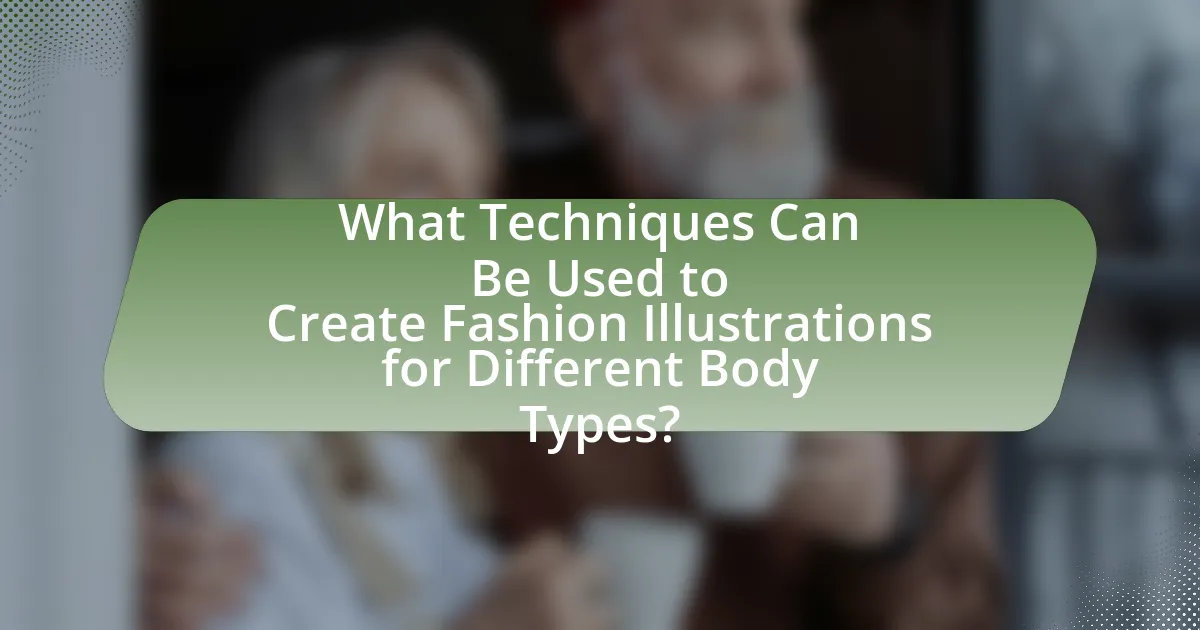
What Techniques Can Be Used to Create Fashion Illustrations for Different Body Types?
To create fashion illustrations for different body types, artists can utilize techniques such as proportion adjustment, silhouette variation, and color theory application. Proportion adjustment involves altering the dimensions of the figure to accurately represent diverse body shapes, ensuring that the illustration reflects the unique characteristics of each body type. Silhouette variation allows artists to emphasize or downplay certain features, such as curves or straight lines, to create a more flattering representation. Additionally, applying color theory can enhance the visual appeal and convey the intended style, as different colors can influence perception and mood. These techniques are essential for producing inclusive and representative fashion illustrations that resonate with a wide audience.
How can proportion and scale be adjusted for different body types?
Proportion and scale can be adjusted for different body types by altering the dimensions and relationships of body features in fashion illustrations. For instance, a pear-shaped body can be represented with a wider lower body and narrower shoulders, while an apple-shaped body may require a fuller upper body and slimmer hips. Adjusting the length of limbs and torso can also enhance the representation of body types; longer limbs may be depicted for taller figures, while shorter proportions can be used for petite body types. These adjustments ensure that the illustrations accurately reflect the unique characteristics of each body type, allowing for a more realistic and relatable representation in fashion design.
What are the best practices for illustrating curves and angles?
The best practices for illustrating curves and angles involve using smooth, flowing lines to represent the natural shape of the body, ensuring that proportions are accurate to convey realism. Artists should focus on highlighting the body’s silhouette by emphasizing key areas such as the waist, hips, and shoulders, which helps in creating a dynamic and visually appealing illustration. Additionally, employing techniques like shading and contouring can enhance the three-dimensionality of curves and angles, making them more lifelike. Studies in figure drawing emphasize that understanding human anatomy and practicing gesture drawing can significantly improve the accuracy of curves and angles in fashion illustrations.
How can color and fabric choices enhance body type representation?
Color and fabric choices can enhance body type representation by creating visual balance and emphasizing or downplaying specific features. For instance, darker colors tend to have a slimming effect, making them suitable for individuals who wish to minimize certain areas, while lighter colors can draw attention and highlight features. Fabrics also play a crucial role; structured fabrics can provide shape and support, enhancing the silhouette, whereas flowy fabrics can create a softer appearance. Research indicates that specific color palettes can influence perceptions of body shape, with studies showing that certain hues can affect how proportions are viewed. For example, a study published in the Journal of Fashion Marketing and Management found that color can significantly impact consumer perceptions of body size and shape, reinforcing the idea that strategic color and fabric choices can effectively enhance body type representation.
What tools and materials are best for fashion illustration?
The best tools and materials for fashion illustration include high-quality sketching pencils, markers, watercolors, and digital illustration software. Sketching pencils allow for precise line work and shading, while markers provide vibrant colors and smooth application. Watercolors add a soft, fluid quality to illustrations, making them ideal for capturing fabric textures. Digital illustration software, such as Adobe Illustrator or Procreate, offers versatility and the ability to easily edit and manipulate designs. These tools are widely used by professional fashion illustrators to create detailed and expressive representations of clothing and body types.
How do digital tools compare to traditional methods in fashion illustration?
Digital tools offer greater flexibility and efficiency compared to traditional methods in fashion illustration. While traditional methods rely on physical materials like pencils and paints, digital tools enable artists to easily edit, manipulate, and experiment with designs without the need for physical resources. For instance, software like Adobe Illustrator allows for instant color changes and layering, which can significantly speed up the design process. Additionally, digital illustrations can be easily shared and reproduced, enhancing collaboration among designers and clients. Studies indicate that digital tools can reduce the time spent on revisions by up to 50%, showcasing their effectiveness in modern fashion illustration practices.
What are the advantages of using mixed media in fashion illustrations?
The advantages of using mixed media in fashion illustrations include enhanced creativity, depth, and texture. Mixed media allows artists to combine various materials such as watercolor, ink, and digital elements, resulting in unique visual effects that can better represent the intricacies of fabric and design. This approach can also facilitate the portrayal of diverse body types by enabling more dynamic and expressive representations, which can resonate with a broader audience. Furthermore, the use of mixed media can stimulate innovation in design concepts, as artists experiment with different techniques and materials, leading to more original and engaging illustrations.
What are some common challenges when illustrating for different body types?
Common challenges when illustrating for different body types include accurately representing diverse proportions, ensuring body positivity, and avoiding stereotypes. Accurately representing diverse proportions is crucial because each body type has unique measurements that can affect the overall aesthetic of the illustration. Ensuring body positivity is essential to promote inclusivity and acceptance, which can be challenging when trying to balance artistic style with realistic representation. Avoiding stereotypes is important to prevent reinforcing negative perceptions about body image, which can alienate audiences. These challenges require illustrators to be mindful of their approach and to prioritize authenticity and sensitivity in their work.
How can illustrators overcome stereotypes in body representation?
Illustrators can overcome stereotypes in body representation by actively diversifying their portrayals of body types in their work. This can be achieved by studying and incorporating a wide range of body shapes, sizes, and features, which reflects the true diversity of human bodies. Research indicates that representation in media influences societal perceptions; for instance, a study published in the Journal of Health Psychology found that diverse body representation can positively impact body image and self-esteem among viewers. By prioritizing inclusivity and challenging traditional beauty standards, illustrators can contribute to a more accurate and empowering depiction of bodies in fashion illustrations.
What strategies can be employed to improve illustration skills for diverse body types?
To improve illustration skills for diverse body types, artists should practice drawing from a variety of reference images that showcase different shapes, sizes, and proportions. This approach allows artists to understand the unique characteristics of each body type, enhancing their ability to depict them accurately. Studies indicate that artists who regularly engage with diverse references develop a more nuanced understanding of anatomy and proportion, which is crucial for creating realistic illustrations. Additionally, participating in life drawing sessions that include models of various body types can further refine an artist’s skills, as it provides direct observation and practice in capturing the subtleties of form and movement.
What are the best practices for creating inclusive fashion illustrations?
The best practices for creating inclusive fashion illustrations involve representing a diverse range of body types, ethnicities, and abilities. This can be achieved by incorporating various body shapes and sizes in illustrations, ensuring that models reflect real-world diversity. Research indicates that 67% of women in the U.S. wear sizes 14 and above, yet traditional fashion illustrations often depict only slim figures, which can alienate a significant portion of the population. Additionally, using models with different skin tones, hair textures, and physical abilities fosters a more relatable and inclusive visual narrative. By prioritizing these elements, fashion illustrations can resonate with a broader audience and promote body positivity.
How can feedback from diverse audiences improve illustration quality?
Feedback from diverse audiences can significantly improve illustration quality by providing varied perspectives that highlight different cultural, aesthetic, and functional preferences. This diversity in feedback allows illustrators to identify and address biases or gaps in representation, ensuring that their work resonates with a broader audience. For instance, research indicates that inclusive design practices lead to higher user satisfaction and engagement, as seen in studies conducted by the Nielsen Norman Group, which emphasize the importance of user-centered design in enhancing product effectiveness. By incorporating insights from various demographic groups, illustrators can refine their techniques and styles, ultimately producing more relatable and impactful illustrations that cater to different body types and fashion sensibilities.
What resources are available for learning more about body diversity in fashion illustration?
Resources for learning about body diversity in fashion illustration include books, online courses, and workshops. Notable books such as “The Fashion Illustration Workbook” by Aaris Sherin provide insights into diverse body types and techniques for representation. Online platforms like Skillshare and Coursera offer courses specifically focused on inclusive fashion illustration, often featuring industry professionals who emphasize body diversity. Additionally, workshops hosted by organizations like the Fashion Institute of Technology (FIT) focus on inclusive practices in fashion illustration, providing hands-on experience and expert guidance. These resources collectively enhance understanding and skills related to body diversity in fashion illustration.
